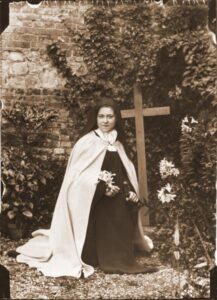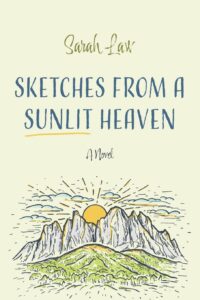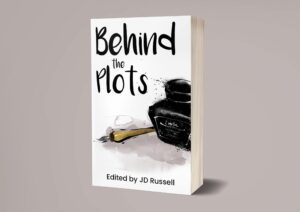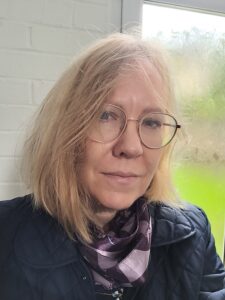Today, we hear from one of the Associate Lecturers who teaches on our Creative Writing MA programme. Sarah Law draws back the curtain to reveal some of the choices and happy accidents that lie behind the final form and title of her recently published novel Sketches from a Sunlit Heaven.
Sometimes writing allows us to meet characters who we don’t correspond with in terms of time or culture, but who speak to us anyway. My novel, Sketches from a Sunlit Heaven, arguably falls into this category: historical fiction where my characters, based on real people, tell their stories.

July 1896, in the sacristy courtyard. Licensed for non-commercial use by Copyright Office Central de Lisieux
By way of an introduction to my subject matter: I have an endless fascination with the ‘Little’ Saint Therese. She lived in a Carmelite Monastery in Lisieux, France, for nine short years before dying of tuberculosis in 1897 at the age of twenty-four. Her own memoir is full of sweetness but granite-tough underneath. Rare archive photos reveal lively eyes and a subtle smile full of some secret I still want to hear. Most unusually, three of her blood sisters and a cousin joined her in the same monastery. One sister was an artist and photographer. Another became prioress for much of her long life, and together they supported the cause of Therese being canonised, which she duly was in 1925 when, had she lived, she would have been fifty-two years old.
I started writing a fictionalised biography, hoping to deepen my knowledge of this young nineteenth-century nun. Then, as I read about her family, particularly her blood sisters, I heard their voices in my head (I mean this figuratively, of course). Pauline, the prim, practical community leader. Marie, the warm-hearted dreamer. Celine, the fiery-tempered artist. And Leonie, the difficult loner. Add in cousin Lucie with a beautiful singing voice, and Maurice, a missionary who fails and fails again, but with whom Therese, toward the end of her life, corresponds with the tenderness of an ethereal lover. Six different perspectives emerged: six distinct, but related, takes on Therese. But how were they going to work together? As each character’s narrative grew, so did my concerns about a clunky jumping from one chapter to another, from one account to the next, especially as they would substantially be going over the same events as each other.
I paused to reflect. I decided that my options were:
- Change the novel’s narrative perspective back to the third person, potentially becoming an authorial presence in my own right;
- Revise my narrative strategy to just one sustained first-person voice;
- Somehow intercalate my various first-person speakers (or at least some of them) into one chronological narrative.
While I considered each option seriously, I decided I wanted to retain the polyphony of multiple voices, even if they weren’t the longest-lived or most substantial in terms of narrative length. I wanted the book to offer a multidimensional account. A series of fragments mapped over Therese’s life and beyond. A mosaic.
Something clicked into place: this was how the novel itself wanted to emerge. A mosaic or a series of sketches, as each speaker passed the narrative between themselves. Sketches from a Sunlit Heaven had found its form and, incidentally, soon afterward, its title.
I embarked on an intense period of copying and pasting as I took what felt like brief but complete episodes from all six of my first-person narratives. I wanted to proceed in chronological order, but alert to the poetic magnetism produced by selective juxtapositions of my speakers’ accounts. Of course, I’m not the first novelist to choose multiple speaking characters (‘intradiegetic narrators’, if you will). From Wilkie Collins’s The Woman in White to George Saunders’ Lincoln in the Bardo, the polyphonic approach to narrating a novel has been successful across recent centuries. Virginia Woolf’s The Waves remains one of my favourite modernist novels. A very tall order to write anything on par with these great works! But, to paraphrase the words of poet Robert Browning in ‘Andrea del Sarto’ a writer’s reach should exceed their grasp, or what’s a heaven for?
As I continued to cut, paste, shape, and write, I imagined jigsaw pieces fitting together to make a whole picture. Neither mosaics or jigsaws are perfect analogies, but both echo images in the novel: pieces of mosaic from the Roman Forum that teenage Celine cherished, and later, Lucie’s imaginative consideration of the ‘jigsaw’ view of Normandy seen from above – looking down from a sunlit heaven.

Sketches from a Sunlit Heaven is published by Wipf and Stock.
Two more motifs appeared as the novel grew into its ultimate structure. Firstly, that of letters. Therese, her sisters, and others close to them or the family wrote to each other a lot. I haven’t framed any narrative fragments as letters per se, but their usual length—from a few hundred words to a thousand or so—is reminiscent of a letter. The epistolary novel is the earliest form of the novel genre in English, so there is perhaps an echo in my work of its literary ancestor. My characters write to each other, request letters, read, receive, and even dream letters. And then there’s the sketch. A sketch is brief, descriptive, often urgent, suggesting with few lines, and judicious shade and hatching, larger issues than itself. Something Celine literally does, as do the others, figuratively. Sketches from a Sunlit Heaven secured its place as my novel’s name.
Combing through my draft, I found it fell into fourteen sections, each bound by dates, and housing narrative fragments that developed the section’s essential kernel—Vocation, Discipline, Legacy, and so on. An introductory section, Glimmerings, also appeared.
It’s strange how, in the end, a novel largely emerges of its own volition. Despite the planning and researching, even historical fiction does too. Holding the published book in my hand, I can say the process of writing it is still part mystery.

With thanks to Writing Bad for permission to publish this blog, which is an abridged version of an essay Sarah Law originally published in Behind the Plots.
 Dr Sarah Law is an Associate Lecturer for the Open University. As well as a novel, she has published six poetry collections and writes academic and creative nonfiction. She also edits the online journal Amethyst Review, for new writing engaging with the sacred. She lives in Norwich.
Dr Sarah Law is an Associate Lecturer for the Open University. As well as a novel, she has published six poetry collections and writes academic and creative nonfiction. She also edits the online journal Amethyst Review, for new writing engaging with the sacred. She lives in Norwich.

Just wanted to say how much I enjoyed reading your post, Sarah. It sounds like a suitably fascinating literary treatment for a really fascinating subject! I could just imagine the sweat and toil involved in the cutting and pasting aspect of the project (why is it so much less gratifying to cut and paste electronically, when doing it in real life is so therapeutic???).